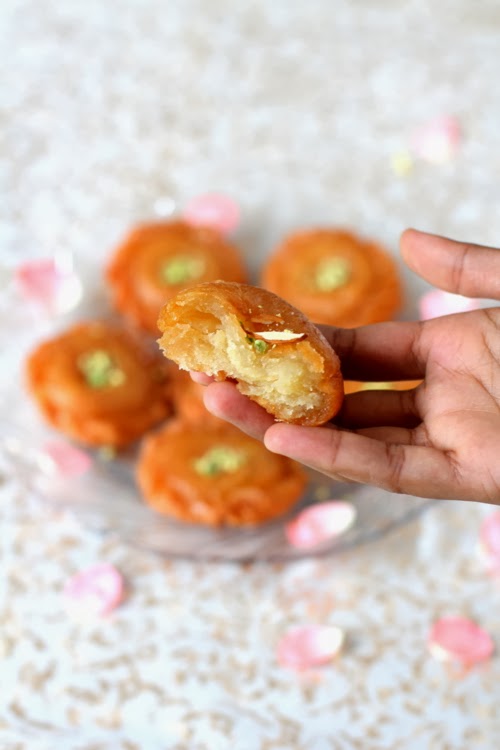Badusha is a popular Indian sweet sold in almost all the mithai stores across the country. It is a flaky, puffy, round shaped, golden colored sweetmeat that is popularly known as Badusha in the South and Balushahi in the North. Small balls that are slightly flattened are shaped out of a dough consisting of flour (maida), ghee and curd, deep fried to a golden shade and dunked in a warm sugar syrup. This classic Indian sweet has an amazing texture with a crisp outer layer and a soft, juicy interior.
It might be intimidating for a beginner wanting to make this Indian sweet. Badusha recipe is not as difficult as one thinks it is. There are certain crucial steps to be followed while making them and if you follow them to the ‘T’, you will be successful. Making depressions in the rolled out balls, cooking them over slow flame and preparing the sugar syrup to the right consistency are the three most important steps that need to be taken care .
Badhusha ~ First Blog Recipe
Prep time: 30 min
Cook time: 30 min
Yield: 14
Main Ingredients: maida sugar
Ingredients
- Maida – 2 cups (all purpose flour)
- Baking powder – 1/2 tsp
- Baking soda – 1/4 tsp
- Sugar – 1 tsp
- Curd – 2 tbsps
- Ghee – 1/4 cup, melted
- Oil – 1 tbsp
- Water – as required
- For sugar syrup:
- Sugar – 1 1/2 cups
- Water – 1 1/2 cups
- Lemon juice – 1/2 tsp
- Cardamom powder – pinch (elaichi)
Method
- In a wide bowl, sift maida, baking powder and baking soda. Add sugar and mix well. Make a well in the center, add curd and ghee and mix with the maida. It should resemble bread crumbs. Add a little more curd if required. Now slowly add little water and make a soft and pliable dough. Leave aside covered for at least an hour.
- In a stainless steel vessel, add sugar and water and allow the sugar to dissolve on medium flame. Reduce flame to low, allow the sugar syrup to thicken lightly. The syrup should be sticky on touch and it should reach one string consistency. Add lemon juice and elachi powder and turn off flame.
- After the dough has rested, do not knead. To prepare badusha, pinch off lemon sized dough and roll into balls. Flatten the balls lightly and make a depression in the center using your thumb. Making the depression is crucial, so do not skip this step. You can also make another shape of the badusha similar to the ones shown in the image above. Lightly flatten along the edge of the flattened ball using the tips of your forefinger and thumb and pinch it inwards to form a pleated edge. Make a slight depression in the center of the badusha.
- Heat oil for deep frying in a heavy bottomed vessel till hot but not smoking hot. Add a small piece of dough into the oil and if it sizzles and comes to the surface, the oil is ready for deep frying. TURN OFF FLAME. Now slowly add 3 to 4 badushas into the hot oil and allow them to rise to the surface of the oil. Do not skip this step. It is similar to how we would fry gulab jamuns.
- Once the badushas surface to the top of the oil, turn on flame to low and cook on both sides till golden brown. The key to a good badusha is in the deep frying. The badushas have to cook slowly and do not rush through the process by trying to cook them on high flame as they will remain uncooked inside. It has to reach golden brown color. Do not over cook it to a darker golden shade.
- Using a slotted ladle, remove the badushas from the hot oil and place them gently in the warm sugar syrup. Once the badusha sits in the syrup, use a ladle and allow it to sink inside the syrup such that it is coated all over. Allow to sit in the syrup till the next batch of badusha is done. In between do flip over to the othe side so that the badushas absorb the syrup evenly. Remove from the syrup and place them on a plate and allow to come to room temperature.
- Store in an air tight container. They stay fresh for at least 3 to 4 days at room temperature. You can refrigerate them for longer shelf life.
Tips
- Cook the badushas on low flame only till they achieve a golden shade. They have to cook slowly so that the insides are completely cooked.
- Soak in sugar syrup for a longer period than specified in the recipe, if you feel the badusha needs more soaking time.
- Try to keep the sugar syrup warm at all times. You can heat over gentle flame to warm it.



No comments:
Post a Comment